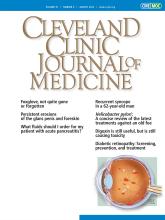A 66-year-old man presented with an 8-month history of persistent erosions of the glans penis and foreskin with slight itching and pain. Physical examination revealed erythema and superficial erosions on the glans penis and foreskin (Figure 1). Similar lesions were not found on the skin or oral mucosa elsewhere. Tests for syphilis were negative.
Erythema and superficial erosions on the glans penis and foreskin before treatment.
Biopsy taken from the foreskin showed suprabasal bullae with acantholysis. Direct immunofluorescence was negative for deposition of immunoglobulin (Ig) G, IgA, and IgM and complement C3 in the epidermal cells and basement membrane bands. However, indirect immunofluorescence tests showed that antispinous intercellular desmoglein antibodies were deposited in the interspinous cell reticulum (using monkey esophagus as a deposition substrate) at a titer of 1:320. No antibasement membrane zone antibodies (important autoantibodies in the diagnosis of bullous pemphigoid) were found.
The patient was diagnosed with localized pemphigus vulgaris. The erosions improved significantly after 2 months of treatment with oral prednisolone at an initial dose of 30 mg daily (Figure 2).
The erosions improved significantly after treatment.
PEMPHIGUS
Pemphigus encompasses a group of rare autoimmune disorders characterized by the development of flaccid blisters and erosions on the skin and mucous membranes.1 These blisters are fragile and can easily rupture, leading to open sores and erosions. The majority of patients present with pemphigus vulgaris.2 Pemphigus vulgaris can affect the skin or mucous membranes throughout the body, including the chest, back, head, and, in severe cases, the whole body, but oral involvement often occurs first. Lesions may localize to a single body site such as the nose, cheeks, or penis, which can easily lead to misdiagnosis.
Other subtypes of pemphigus include pemphigus foliaceus and rare pemphigus variants like paraneoplastic pemphigus and IgA pemphigus. Pemphigus foliaceus manifests with skin lesions, usually without mucosal involvement.1 Patients with paraneoplastic pemphigus have known or potential tumors, usually of lymphoid tissue. Pain and severe oral and conjunctival erosions are the main features. The staining patterns on direct and indirect immunofluorescence differ in paraneoplastic pemphigus and classical pemphigus and can be used to distinguish between them.2
The differential diagnosis
Pemphigus should be distinguished from bullous pemphigoid, severe erythema multiforme, and drug-induced bullosa epidermolysis. Persistent erosions on the glans and foreskin of the penis are often encountered and have a wide differential, including syphilis, herpes simplex virus infection, candida balanitis, lichen planus, psoriasis, other autoimmune diseases, trauma, and skin cancer.3 Pemphigus vulgaris can be differentiated from these diseases through histopathology, immunofluorescence, and autoimmune serum titers.2,4
Diagnosis and treatment
Diagnosis is based on clinical presentation, histopathology showing intraepidermal acantholysis, and either positive findings on direct immunofluorescence (ie, IgG or complement C3 deposits at the surface of keratinocytes) or detection of serum autoantibodies against epithelial cell surface.4,5 Samples for biopsy should be taken from normal-appearing skin immediately adjacent to a lesion; sampling inflamed or blistered skin may lead to false-negative results on direct immunofluorescence5 because the inflammatory process associated with pemphigus can damage immune deposits.1
First-line treatments are corticosteroids and anti-CD20 monoclonal antibodies.4 In patients with moderate to severe disease, combination therapy may be used to improve efficacy and reduce the dose of glucocorticoids at the start of treatment or when the effect of glucocorticoids alone is not significant. First-line immunosuppressants are azathioprine and mycophenolate mofetil.
The initial dose of glucocorticoids depends on the type and severity of disease. The absence of new blisters indicates that the dose is adequate. Conversely, the dosage should be increased or other immunosuppressive agents added if new blisters appear. Once disease control is observed, the dosage should be reduced slowly and gradually to prevent recurrence. Withdrawal of systemic corticosteroids may be proposed in patients in complete remission on minimal therapy.2
DISCLOSURES
The authors report no relevant financial relationships which, in the context of their contributions, could be perceived as a potential conflict of interest.
- Copyright © 2024 The Cleveland Clinic Foundation. All Rights Reserved.








